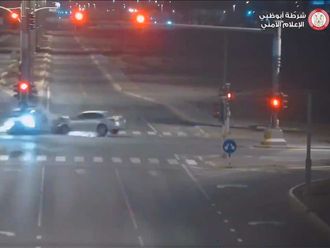
Dubai: A relaxing road trip to Oman this Eid Al Adha break not only sounds like a good idea, but is also affordable compared to a flight to any other destination.
Luckily, for UAE expatriates and other nationalities residing in Gulf Cooperation Council (GCC) countries, they are eligible for a visa on arrival, and going through the border checkpoint is quite an easy process – if you are aware of all the rules.
So, to make sure you do not face any hiccups on your road trip, here is all you need to know about the visa and car insurance requirements for driving to Oman.
Visa requirements for UAE residents travelling to Oman by road
“You do not need to apply for a visa in advance. UAE residents can get a visa on arrival stamped on their passport, and this allows for a stay of 14 days in Oman,” Latheef MC, visa consultant at Dubai-based travel agency, Anisha Travel and Tourism, said.
If you are planning to stay for longer than that, then you must apply for an eVisa in advance, which would allow you to stay in Oman for up to 30 days.
However, according to Oman’s eVisa platform it normally takes at least four to five working days for the visa to be approved. If you are going for a shorter break, you can apply for a 14-day visa on arrival at the UAE-Oman border.
Additionally, Latheef stated that there are certain nationalities that are allowed to enter Oman visa free through the border. However, it is important to check with the Oman Embassy or call the Royal Oman Police (ROP) contact centre – +968 2284820, to find if you are eligible for visa-free travel.

UAE residents can get a visa on arrival stamped on their passport, and this allows for a stay of 14 days in Oman.
Visa cost
• Visa on arrival fee – 5 OMR (Dh47).
• Exit fee – Dh35 (this needs to be paid when you are exiting the UAE border).
• Motor insurance (if your existing insurance does not cover driving in Oman) – Dh106 or higher, depending on the coverage.
Documents required
• Valid Emirates ID.
• Passport with at least six months validity.
How to enter Oman from the UAE by road - five border crossings to know

1. Al Darah border post
Route Ell, through Ras Al Khaimah, connects UAE residents to the northern most region of Oman - the Khasab area of Musandam, which is a governerate of Oman. Musandam is an exclave of Oman, separated from the rest of Oman by areas of the UAE. It is popular among tourists because of its boat cruises that offer the chance to sight dolphins, snorkeling and off-roading in the Hajar mountain range.

2.UAE/Oman Dibba border post
Route E99, through Fujairah, connects UAE residents to the south of Musandam, to the areas of Dibba and Zaghi.
3.Khatmat Milaha border post
If you drive along Route E99 in the other direction through Fujairah, it will connect you to the northern part of Oman, opening up the cities of Sohar and Muscat.
4.Hatta Crossing/Al Wajajah border post
Along the borders of UAE and Oman, the next crossing is the Al Wajajah Crossing, which you can reach by driving down Route E44. This is another route you can take if you wish to access the capital Muscat or wish to explore the northern areas of the country.
5.Mezyad border post
Another border crossing through Al Ain is the Mezyad border post. When you are on route E40, take the exit for Zayed Bin Sultan Street, to reach the border crossing.
This border crossing connects you to the southern part of Oman, including Salalah, which is a popular destination during the summer months. This is because from June to September this area experiences monsoon, as Oman marks the Khareef/monsoon season.

What to do when you arrive at the Oman border
Step 1: Pay exit fee
When driving to Oman, you would first be crossing the UAE border post, where you would need to pay an exit fee of Dh35, according to Latheef.
Step 2: Get the visa stamped on your passport
“Next, when you are proceeding to the Oman border, you will need to park the car and enter the immigration section, where the visa will be issued and the passport will be stamped,” MC said.
Step 3: Apply for motor insurance for Oman, if you don’t already have one
Before you decide to travel, contact your insurance provider to find out if your policy includes Oman coverage.
“Major insurance companies in the UAE offer Oman coverage for free along with their comprehensive cover,” Hitesh Motwani, the Chief Marketing Officer at InsuranceMarket.ae, said.
In case your current motor insurance does not cover you for driving in Oman, you can purchase a policy at the border. Motor insurance for Oman is also referred ‘Orange Card’.
“The ‘Orange Card’ can also be purchased at the border, but this is limited to ‘third party cover’ only. In case of an accident, your car will not be covered,” he explained.

The ‘Orange Card’ can also be purchased at the border, but this is limited to ‘third party cover’ only. In case of an accident, your car will not be covered.
According to Latheef, when purchasing the insurance policy at the border, the minimum duration of the policy that you can purchase is for five days, which costs approximately Dh106.
“Most vehicles in the UAE have GCC insurance coverage. If not, you can go to one of the self-service kiosks and purchase car insurance with at least five days coverage. This costs around Dh106,” he added.
Step 4: Undergo car inspection
After the whole process is complete, the car will undergo a short inspection by the customs officers at the border, after which you will be able to enter Oman.
Driving in a car borrowed from a friend or family member? You need to have a No Objection Certificate (NOC)
You can drive to Oman in a borrowed vehicle, however, you need to have a No Objection Certificate (NOC) from the car owner. The NOC must be notarised and translated to Arabic. The letter will state that the owner has given permission to the driver to use their vehicle, and it should include the chassis number, vehicle registration details and the Emirates ID number of the driver.
Valid pass
Car insurance certificate
'Orange card' - this only required if your current motor insurance does not cover you for driving in Oman, you can purchase a policy at the border. This is commonly referred to as ‘Orange Card’.
Valid driving licence
Valid vehicle registration card
Vehicle ownership certificate
No Objection Certificate (NOC) - if you are driving in a borrowed vehicle.
For how long can you stay in Oman?
• 14 days – visa on arrival
• 30 days - eVisa











